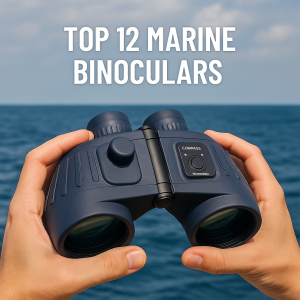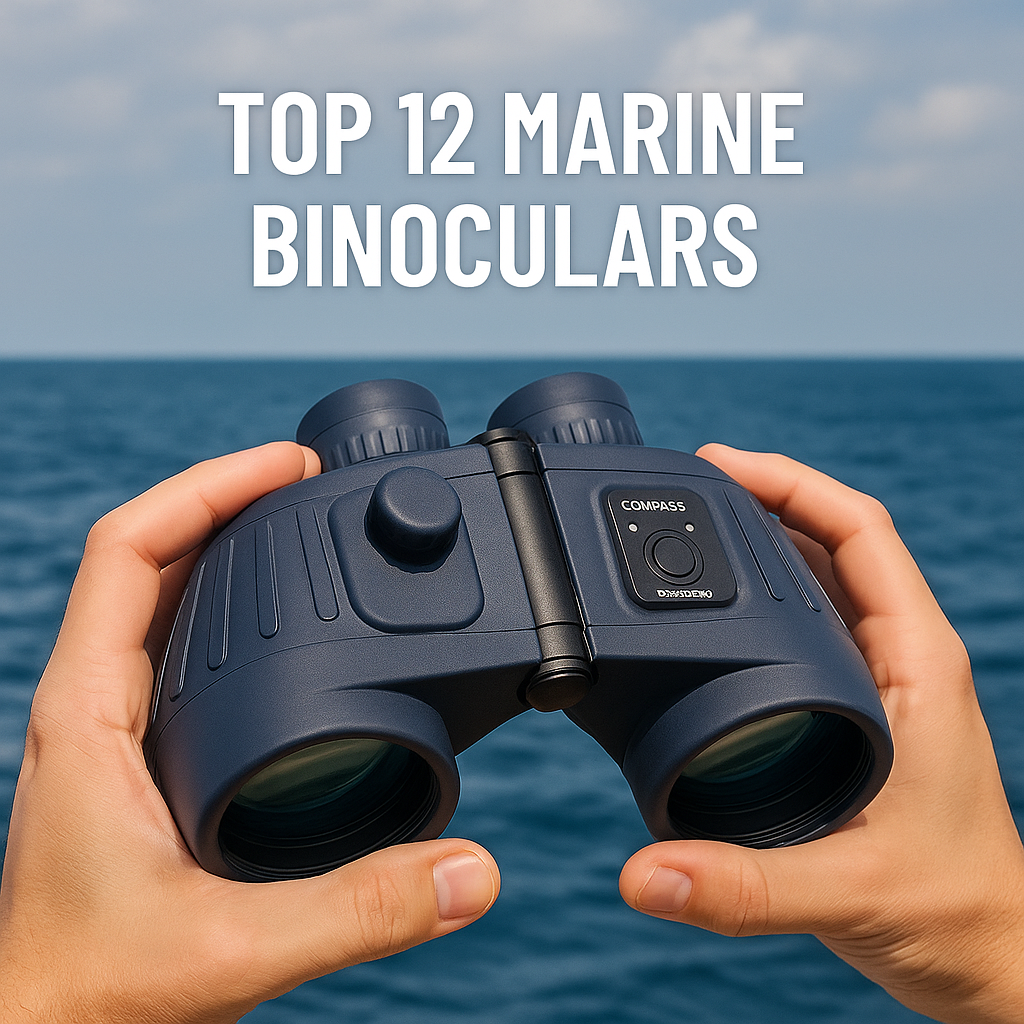Discover the 12 best marine binoculars trusted by professional mariners worldwide. Learn about their features, performance, and how to choose the perfect pair for safe and efficient maritime operations in this comprehensive guide.
Standing on a ship’s bridge with wind in your face, salt on your lips, and the sea stretching endlessly ahead, one essential tool stands between you and potential hazards: a good pair of marine binoculars. Whether you are an officer on watch, a professional mariner, a recreational sailor, or a maritime student learning the ropes, reliable binoculars can mean the difference between spotting a distant buoy in time or colliding with an uncharted obstacle.
In today’s modern maritime industry, with ECDIS charts, AIS data, and radar, you might wonder: Why do we still need traditional binoculars? The answer is simple. Human eyes, trained and aided by optics, provide depth, movement perception, and a visual double-check that no technology can fully replace. That is why international regulations like SOLAS and port state control inspections still expect a reliable pair of binoculars on board.

Why Marine Binoculars Matter in Modern Maritime Operations
The global maritime community transports over 80% of international trade (UNCTAD, 2024). Despite the high-tech bridge systems on modern ships, visual lookout remains a mandatory safety practice under SOLAS Chapter V Regulation 5.
Marine binoculars are designed to withstand the ocean environment — harsh salt spray, rough handling, sudden rain, and intense sun. Standard land-based optics cannot survive these challenges. Good marine binoculars feature nitrogen or argon gas purging, waterproof seals, shockproof casing, and wide field-of-view lenses optimized for movement on a rolling ship.
According to the International Chamber of Shipping, poor visibility and inadequate lookout are among the top five contributors to maritime collisions (ICS, 2023). It’s clear: marine binoculars save lives.
Key Technologies Transforming Marine Binoculars
Binoculars have changed dramatically in the last decade. Advanced lens coatings now maximize light transmission, helping watchkeepers spot hazards at dusk or dawn. Modern models incorporate:
- Range-finding compasses, often stabilized electronically
- Reticle scales for estimating distances
- Stabilisation gyroscopes to counter vessel roll
- Rubber armor and non-slip coatings for secure handling
- Water- and fog-proofing with nitrogen purging
Manufacturers like Steiner, Fujinon, Nikon, and Bushnell have brought cutting-edge military-grade tech to commercial and leisure marine markets, improving safety even for smaller vessels and yacht sailors.
–
Top 12 Marine Binoculars for 2024–2025
Below, we dive deep into the 12 best marine binoculars available today. Each is highlighted not with marketing clichés but with real-world features and benefits that matter to maritime professionals.
Steiner Commander 7x50c
A benchmark among ship officers, the Steiner Commander 7x50c has a stabilized analog compass visible through the eyepiece, giving fast bearings while scanning. Its Sports-Auto-Focus means no constant re-focusing, which is a blessing in rough seas. Rugged, nitrogen-filled, and built to survive decades of bridge duty.
Fujinon Polaris FMTRC-SX 7×50
Fujinon’s Polaris series uses ED (extra-low dispersion) glass for exceptional color accuracy. Their rugged metal housing, Porro-prism design, and waterproof seals make them a popular choice for commercial pilots and trawler captains in cold climates.
Nikon OceanPro 7×50 CF WP
Lightweight, bright, and affordable, the Nikon OceanPro offers an impressive waterproof casing with nitrogen gas purging to resist fogging. A perfect balance of quality and price for yachting skippers and deck officers on budget-limited ships.
Steiner Navigator Pro 7×50
This model is the “little brother” of the Commander, with many of the same rugged features but a more accessible price point. The integrated compass is well suited for smaller vessels where budget and space are tight.
Fujinon Mariner 7×50 WPC-XL
These binoculars bring a built-in compass and floating design to budget-conscious sailors. Despite being one of the lightest in its class, the Fujinon Mariner offers good optical clarity and decent durability for day sails and short voyages.
Bushnell Marine 7×50 Waterproof
Bushnell’s offering is surprisingly solid with multi-coated optics, rubber armor, and a corrosion-resistant housing. They’ve been a popular fallback for training academies due to their cost-effectiveness and reasonable optical performance.
Canon 10x42L IS WP Image Stabilized
Canon’s IS (image stabilization) technology is brilliant if you need higher magnification than the usual 7×50 standard. Though expensive, these are a game-changer for offshore fishing captains or navigators who need to see far with steady hands.
Steiner Commander Global 7x50c
A high-end variation of the Commander series, the Global version works across worldwide magnetic zones without needing local calibration — ideal for international shipping.
Sig Sauer Zulu9 11×45
Though less common at sea, these are increasingly found on offshore support vessels, offering powerful magnification with HDX lenses and EXO barrier coatings that resist salt, oil, and water.
Fujinon Techno-Stabi 14×40
For those in rescue or patrol operations, these high-magnification binoculars with gyro-stabilization allow stable scanning even on turbulent seas. Used by many coast guards worldwide.
Bresser Nautic 7×50 Compass Pro
This German-made binocular is compact, easy to hold, and includes a basic compass and reticle scale for distance estimations. A workhorse for budget-limited patrol craft or pilot boats.
Vortex Kaibab HD 18×56
If you need long-range scanning from a stable bridge or observation platform, the Vortex Kaibab is an incredible piece of optical engineering, though you will need a tripod or shipboard mount for practical use.
–
Challenges and Solutions in Choosing Marine Binoculars
Marine binoculars must cope with punishing weather, constant salt spray, sudden temperature swings, and even the risk of being dropped on a steel deck.
Challenge 1: Saltwater Corrosion
Marine binoculars must use corrosion-resistant materials and sealed nitrogen- or argon-purged interiors. This prevents fogging and protects the delicate prisms and lenses.
Challenge 2: Stabilisation
Even a gentle swell can bounce your view so much that you lose track of a distant buoy. Gyro-stabilized models like Canon IS or Fujinon Techno-Stabi counteract this problem, though they are more expensive.
Challenge 3: Compass Reliability
Built-in compasses are very useful, but some models struggle with magnetic deviation. Professional mariners should test compasses before a voyage, especially near large steel structures.
Challenge 4: Budget
A working pair of marine binoculars doesn’t have to cost thousands, but you should never buy purely on price. Binoculars are a safety tool, like a life raft — you buy them to save lives, not just to tick a checklist.
Real-World Applications and Case Studies
Let’s look at how these binoculars make a difference in the field:
Harbor Pilots and Binoculars
Port pilots frequently use models like Steiner Commander or Fujinon Polaris because they need fast, reliable scanning of approaching ships. In fog or dusk, their wide objective lenses pull in just enough light to spot a navigation light at the far edge of a channel.
Search and Rescue Operations
Rescue crews in rough seas rely on gyro-stabilized binoculars to search for people overboard. In a SAR mission in the North Sea in 2022, a German rescue helicopter crew used Fujinon Techno-Stabi to scan for survivors from a capsized fishing vessel. They credited the binoculars with providing clear images despite pounding winds and rain.
Yacht Owners
Modern yacht captains often pick models like Steiner Navigator Pro or Nikon OceanPro because they offer good waterproofing, light weight, and simple compass reticles.
Merchant Vessels
Large cargo vessels generally fit at least two pairs of robust 7×50 binoculars on the bridge, in compliance with SOLAS requirements. Even with advanced ECDIS and radar, the human lookout remains the final safeguard against collisions.
Future Outlook for Marine Binoculars
The future of marine binoculars is being shaped by technology. Expect to see:
- Digital overlays that add AIS data into your view
- Augmented reality for overlaying buoy names, ship IDs, or even depth soundings directly through the binocular lens
- Higher-magnification stabilisers powered by AI sensors
- Eco-friendly manufacturing with more sustainable materials, driven by IMO’s green ship initiatives
While these sound futuristic, pilot projects are already underway, inspired by military technology and port state control interest in reducing collision rates.
Frequently Asked Questions
What is the best magnification for marine binoculars?
Generally 7x magnification with 50 mm objective lenses (7×50) is the standard for a stable view and enough light in low conditions.
Why do marine binoculars often have a compass?
So you can quickly estimate a bearing to a buoy, landmark, or ship without switching tools.
Are stabilised binoculars worth it?
For rough seas or high magnification, yes — they can mean the difference between seeing and missing a hazard.
Can you use land binoculars on a ship?
You can, but they will likely fog, corrode, or even break quickly. Marine binoculars are built to resist these harsh conditions.
Do regulations require binoculars on ships?
Yes. Under SOLAS, vessels must maintain a proper lookout by sight and hearing, and good marine binoculars are part of that standard.
How long do marine binoculars last?
With care, a quality pair can last 10–20 years or more, depending on service conditions.
What is nitrogen purging?
It’s the process of replacing air inside the binocular with dry nitrogen to prevent fogging and corrosion.
Conclusion
At sea, a reliable pair of marine binoculars is more than just an accessory. It is a critical safety instrument that protects ships, cargo, and lives. While GPS, radar, and AIS are vital tools, they cannot match the human eye’s quick judgment, supported by a clear pair of binoculars. From professional bridge officers to coastal sailors, these top 12 marine binoculars can help you navigate with confidence in a world where marine safety standards grow ever more demanding.
If you want to explore more on this topic, check IMO’s Polar Code guidance, your flag state’s maritime safety regulations, or explore courses on lookout skills at training centers like the World Maritime University or Lloyd’s Maritime Academy.

